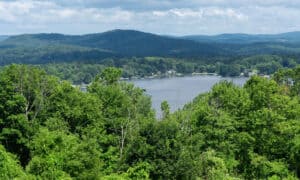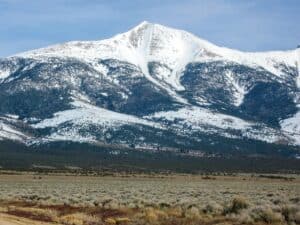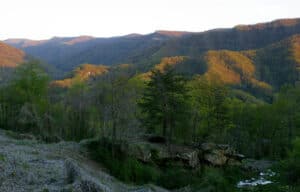While you might be more familiar with the famous Mammoth Cave in Kentucky, Wind Cave National Park in South Dakota calls for a visit. The unique cave contains some of the most distinctive cave features, like boxwork and stunning gypsum frostwork. Surrounding the cave, the National Park contains amazing wildlife living in 28,295 acres of rolling grasslands, hills, ravines, and pine forest.
Learn more about the park and consider this your invitation to visit this hidden national gem.
History of Wind Cave National Park
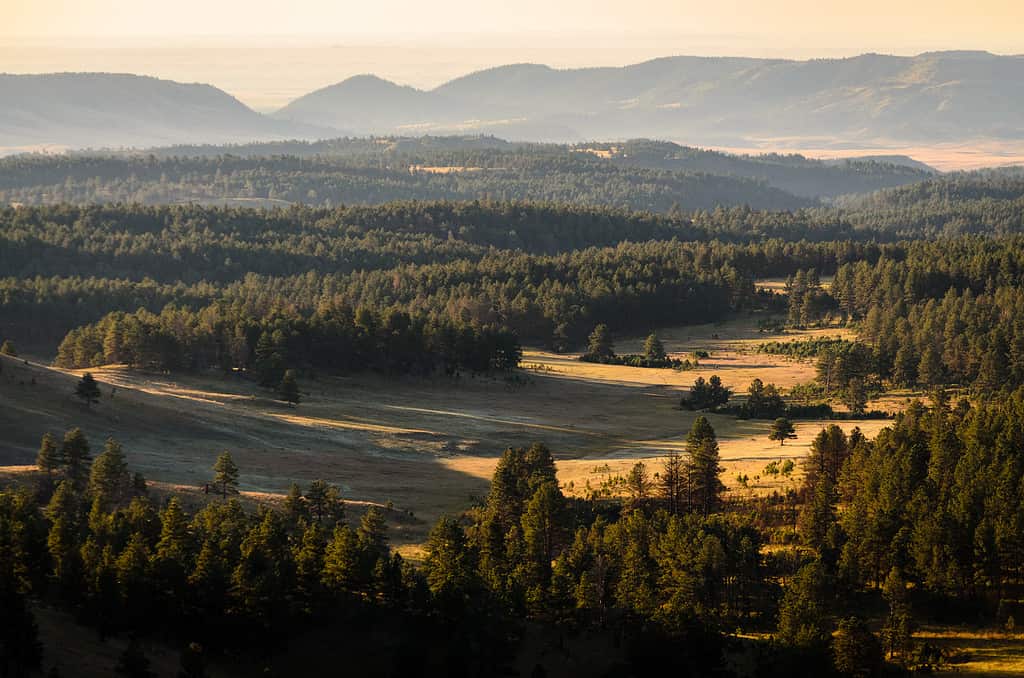
Wind Cave National Park, South Dakota has more to offer than just the cave “discovered” in the 1880s.
©Zack Frank/Shutterstock.com
Protected since 1903, Wind Cave National Park contains much more than an intriguing cave with unique geological features. The earliest records of the cave demonstrate the first excursions kept folks safe from danger on some occasions and revealed potential hidden natural treasures for others. At the time of the park’s founding, it was the seventh national park to come into existence in the United States.
Prior to this time and since, the cave has held significance for the nearby First Nations of South Dakota. European settlers didn’t know about the cave until 1881, though, until Jess and Tom Bingham went in search of the whistling noises they heard. The sound led them to the sacred cave’s only natural entry point. Allegedly, a strong wind blew from within off Jesse’s hat and thus earned the cave its name. Today, folks still notice this wind as they approach the entrance.
Years later, Alvin McDonald followed the wind through the passageways and discovered the extensive network beneath the soil. As McDonald and others began exploring the cave more frequently, word got out and more and more folks came to see for themselves what these caves might contain. The McDonalds and others blasted holes to create other entries to passageways and began leading tours through the caves for a fee.
In 1903, when the area came under protection, these blasts and removal of cave formations were stopped. Tours, however, remained in place, with safety precautions and features added along the way.
Purpose of the Park’s Designation
Beyond preservation of the cave, the park’s purpose is primarily in maintaining a wildlife sanctuary for elk, bison, pronghorn and other wildlife from the Black Hills that have seen dramatic population decline in the nation’s past.
Today, visitors enjoy meandering through the paths with the assistance of a guide, though, of course, no tour covers all 100+ miles of the passageways.
Geology and Geography of Wind Cave National Park
Situated within the Black Hills of South Dakota, Wind Cave National Park offers unique insights into the geology of the region. The Black Hills contain exposed rock units in the dome-shaped crustal uplift which create the hills. These exposed rocks create a sort of “bullseye” visual around the center of the hills. These rocks are gneisses and granite. Moving away from the center of the hills, limestone, shales, and sandstones are exposed.
Within Wind Cave National Park, the oldest rocks have been exposed in the northwest section. You’ll find schists, a metamorphic rock, pegmatites, and igneous rock. Sedimentary rocks to the southeast, progressively age downward to the age of the dinosaur, about 60 million years ago.
How Geology Has Shaped the Landscape
An uplift of the earth, around 65 million years ago, began to reshape the land closer to what it is today in the Black Hills. Since then, though, weathering, minor additional uplifts, and erosion have completed this contemporary experience of the landscape.
Sediments from erosion have filled valleys or spilled eastward out of the park area, forming the Badlands National Park region. Hard rocks like pegmatites, limestone, and sandstone, have formed the ridges and plateaus over time. Weaker rocks, like shales and schists, have formed the valleys. You can see examples of limestone, shale, and sandstone formations within Beaver Creek Canyon, Red Valley, and Wind Cave Canyon. Drive along State Route 87 to see the visible evidence of schist and pegmatite formations.
What Lurks Inside Wind Cave National Park
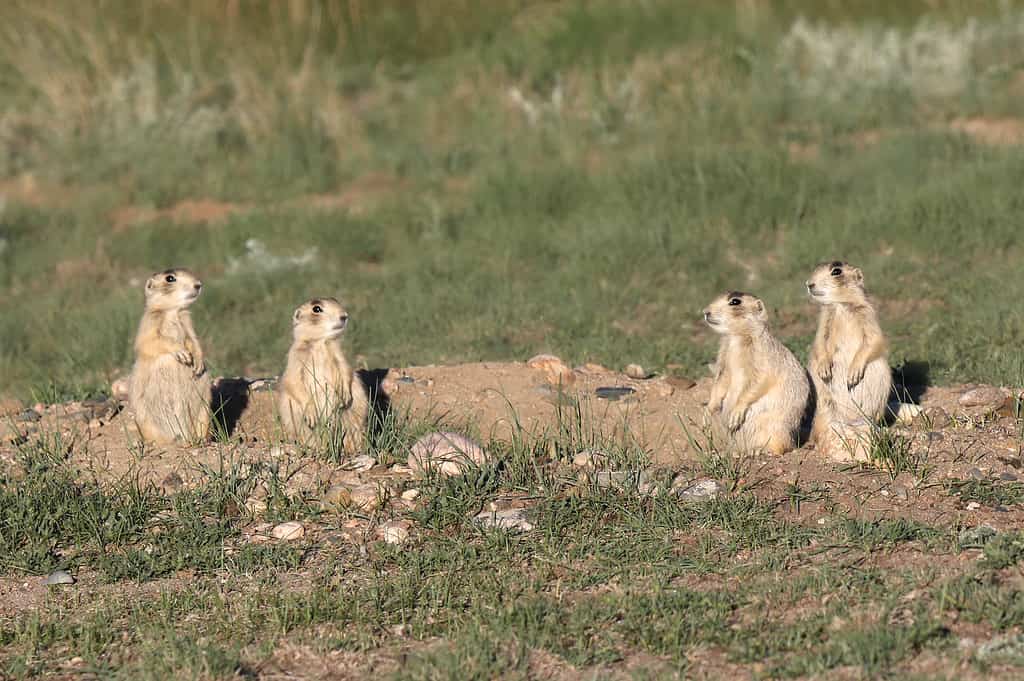
Prairie dog
s, pronghorns, bison, golden eagles, and many other creatures call Wind Cave National Park their home.
©vagabond54/Shutterstock.com
Thanks to its location along the southern edge of the Black Hills, Wind Cave National Park offers habitats for many wildlife species. While visiting the park, you may witness a variety of wild animals and birds. Some will hide within the cave itself, while others inhabit the land surrounding the cave.
You might spot:
- Woodhouse’s toad
- Common snapping turtle
- Western painted turtle
- Yellow-bellied racer
- Garter snake
- Prairie rattlesnake
- Milksnake
- Bullsnake
- Tiger salamander
- Western hognose snake
- Yellow-breasted chat
- Eastern bluebird
- Redheaded woodpecker
- Black-billed magpie
- Golden eagle
- Northern flicker
- Western meadowlark
- Eastern bluebird
- Mountain bluebird
- Sharp-tailed grouse
- Wild turkey
- Red-tailed hawks
- Burrowing owl
- Great horned owl
- Northern saw-whet owl
- Western tanager
- Bison
- Black-footed ferret
- American badger
- Elk
- Prairie dog
- Pronghorn
- Mule deer
- Bobcat
- Mountain lion
- Coyote
Natural Features of Wind Cave
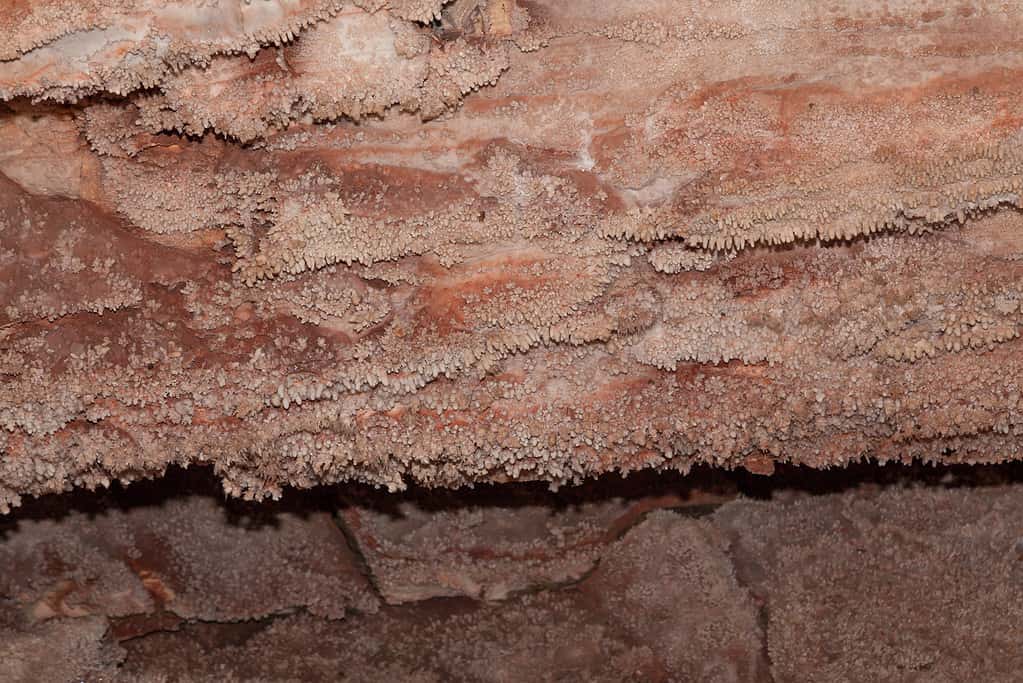
A detailed section of frostwork and popcorn cave features at Wind Cave National Park, South Dakota.
©Tami Freed/Shutterstock.com
Within Wind Cave, many natural formations are on display in all their unique beauty and fascinating shapes. These are created primarily from calcite, speleothems, and aragonite.
Dogtooth Spars
Calcite crystals shaped like spears have been called dogtooth spars, as they often line small pockets in limestone, a bit like teeth in a dog’s mouth. Dogtooth spars are frequently found in caves throughout the Black Hills, not just Wind Cave.
Helictite Bushes
Curious formations in Wind Cave include something called helictite bushes. These formations grow in large, bush-like clusters of calcites, branching and twisting like gnarled shrubs. In Wind Cave, the largest helictite growth stands 6 feet tall, coming up from the floor. These growths usually do come from the floor of caves and caverns, but not always.
Helictite bushes form when water seeps into a cave and through the pores. Flow is controlled not by gravity, but by capillary action, allowing water to flow uphill to deposit these growths.
Boxwork
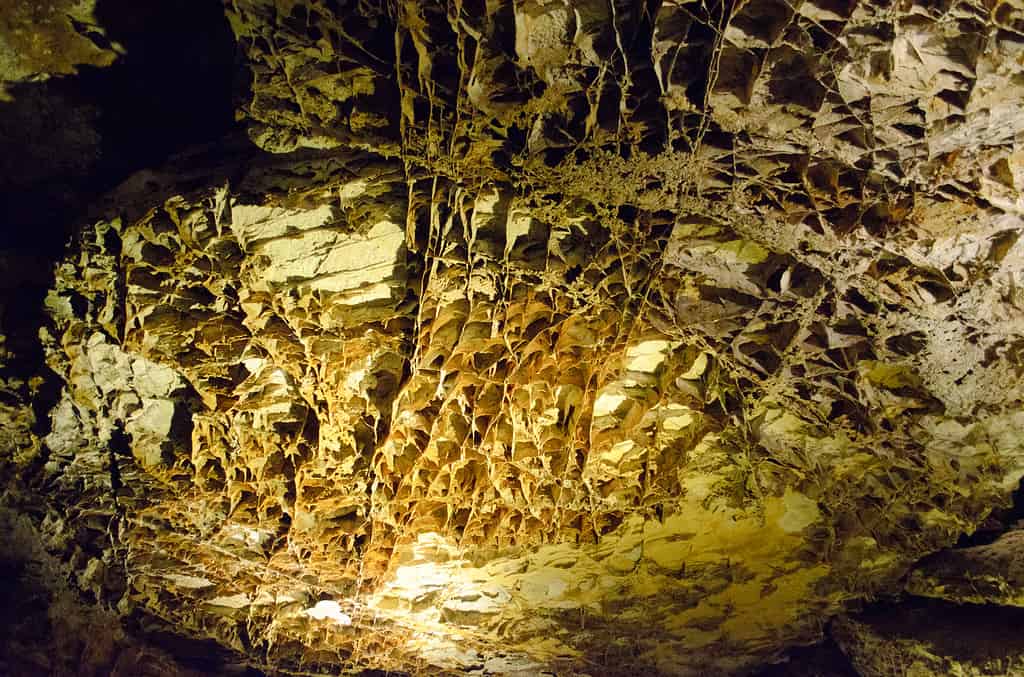
Wind Cave National Park’s unique boxwork formations are some of the most well-formed in the world.
©Zack Frank/Shutterstock.com
Of all the natural features of Wind Cave, boxwork is what makes the cave so unique and intriguing for cave fans the world over. Boxwork rarely forms but in Wind Cave, there’s plenty of it. In fact, Wind Cave has the most well-formed boxwork of any known caves in the world. These formations hang from ceilings and line walls of the caves. Boxwork formation processes are uncertain, but the affects are impressive. The honeycomb-like structures for these “boxes” along the ceiling and walls of the cave, using thin blades of calcite. The fins from the formations intersect at various angles to create these box shapes.
Cave Popcorn
Looking a bit like popped kernels, cave popcorns are small knobby calcite growths on cave walls. These form when water seeps uniformly out of limestone or drips from walls or ceilings to splash on the floor.
Frostwork
Growths of calcite or aragonite may form into delicate, needle-like structures called frostwork. These elegant looking growths often grow on top of cave popcorn or boxwork. The exact formation process is uncertain, with some experts believing that evaporation plays a role in its formation. In Wind Cave, frostwork appear primarily in passages with above average airflow.
Flowstone/Dripstone
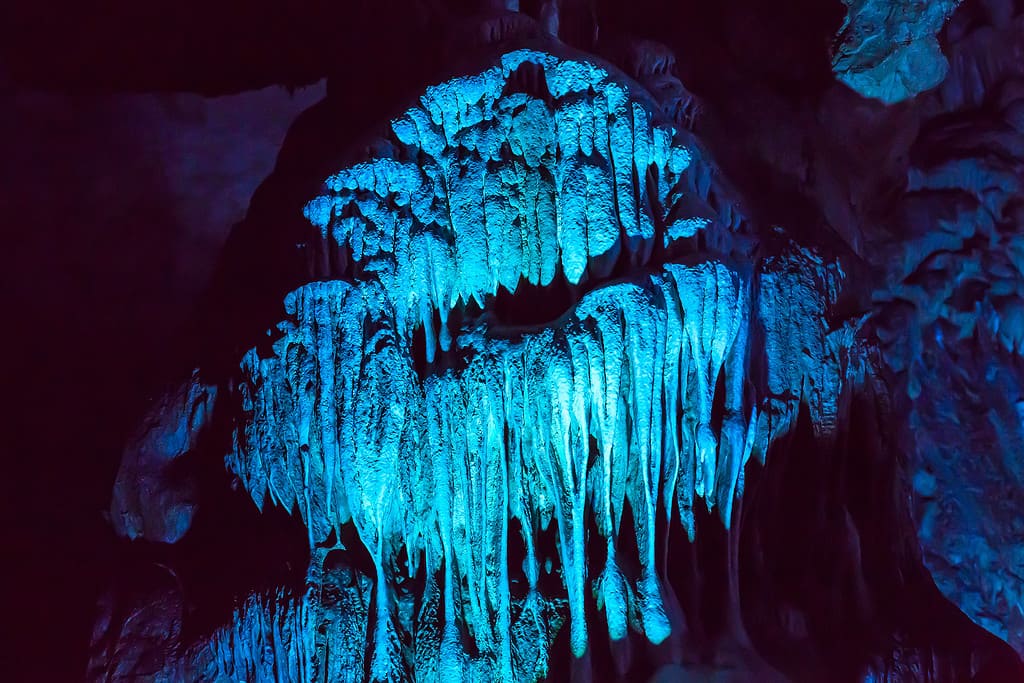
Flowstone or dripstone forms in caves like Wind Cave thanks to calcite drips through the cracks of cave ceilings and walls.
©Nataliya Nazarova/Shutterstock.com
Calcite trickles through caves to concentrate in cracks and deposit there. These deposits are known as flowstone or dripstone. These become solid as time passes, becoming stone-like. Stalactites and stalagmites frequently form from these flowstones. Wind Cave doesn’t contain many of these, though, which has baffled geologists for decades.
Calcite Rafts
Thin sheets of calcite floating on the surface of Calcite Lake are known as calcite rafts. These thin rafts float along in the deepest part of the cave until more calcite clings to them and they become too heavy and sink. Calcite rafts sometimes litter cave floors that are dry, as well, after flooded passages have cleared.
Gypsum Features
In dryer sections of Wind Cave, gypsum crystals have formed. These natural minerals contain sulfur and calcium and often form needle-like crystals radiating out from clusters along the cave floor. Sometimes, gypsum looks more like cotton puffs or clusters of coiled or curved crystals (called gypsum flowers).
Visiting Wind Cave National Park
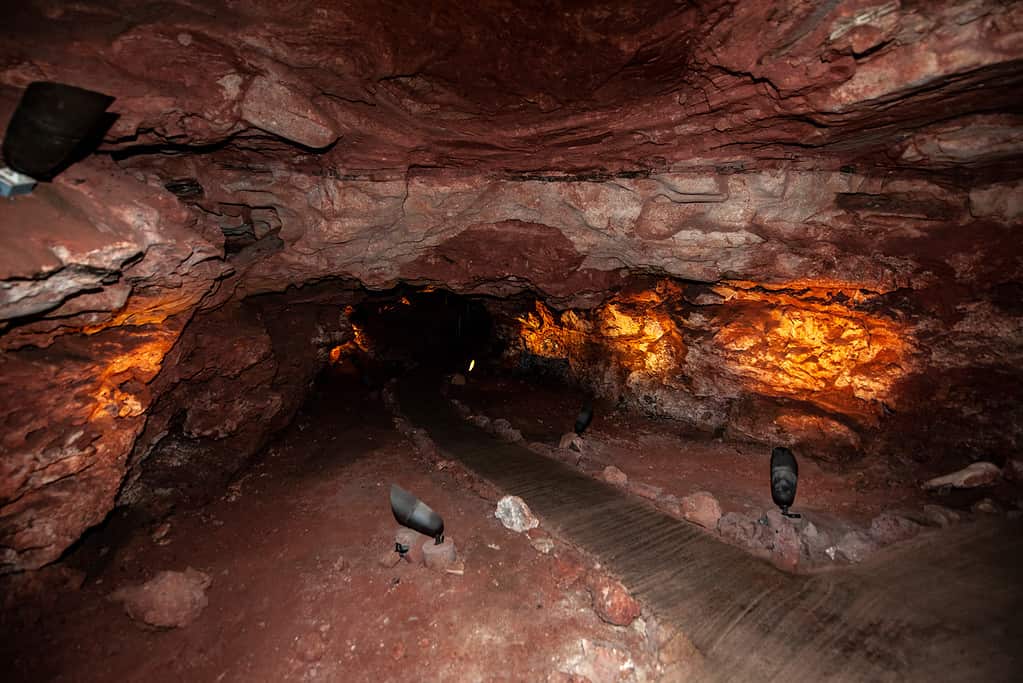
While presumably you’ll want to tour the underground wonders of Wind Cave National Park, South Dakota, there’s plenty more to do here, too.
©Mahmoud Ghazal/Shutterstock.com
Wind Cave National Park provides visitors with many exciting opportunities and activities. Wildlife viewing of bison, pronghorn deer, and prairie dogs, birding, and scenic drives add on to the adventure of exploring the cave.
Visitor Center
Come to the Visitor Center for books, brochures, audio-visual programs, and exhibits about the cave and park. Purchase tour tickets and find activity schedules as well. The center is open daily, save Christmas, Thanksgiving, and New Year’s Day.
Scenic Drives and Rides
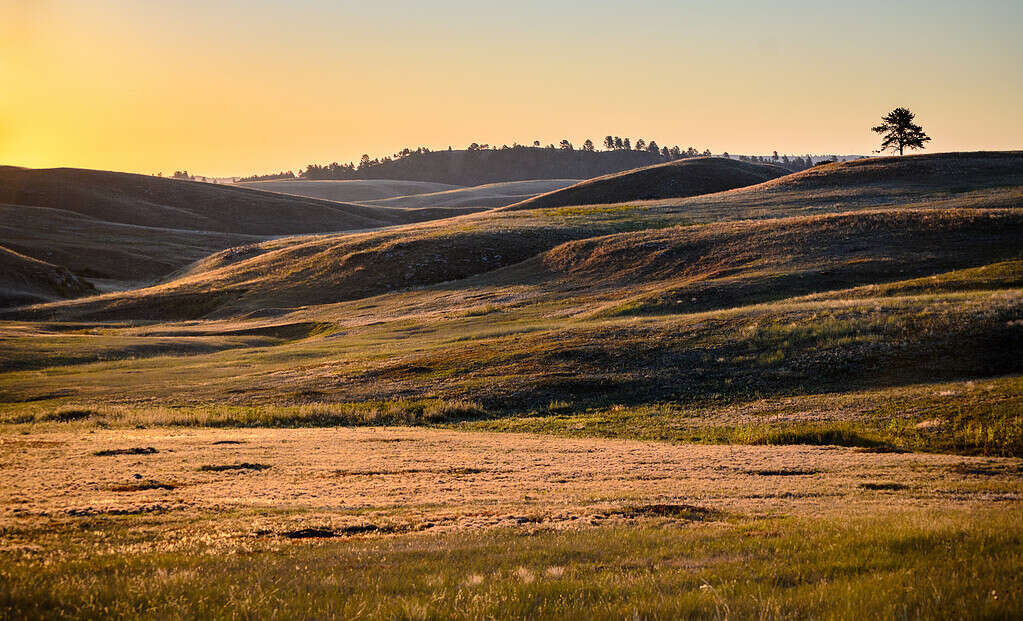
Stunning landscapes await as you visit Wind Cave National Park in South Dakota.
©Zack Frank/Shutterstock.com
Throughout Wind Cave National Park, the drives offer beautiful, scenic views and opportunities for wildlife viewing. These same roads are the only locale where bicycling is permitted in the park.
Picnic Areas
Picnic tables and access to water may be found in the picnic area within the ponderosa pine woodland.
Camping
75 campsites for tents and Recreational Vehicles rest within Wind Cave National Park. The campground welcomes guests between April and October, on a first-come, first-served basis. Picnic tables, restrooms, fire grills, and water are available on the grounds.
For those interested in backcountry camping, this is available as well, as long as you have a permit.
Hiking, Running, and Biking Trails
Throughout Wind Cave National Park, various trails exist for hikers, bikers, trail runners, and campers. Three self-guiding trails take visitors through grasslands and ponderosa pine forests. Be sure to go to the Visitor Center for booklets and maps for each trail.
- Rankin Ridge Trail goes for 1.25 miles, climbing to the top of Rankin Ridge, the highest point in the park.
- Elk Mountain Trail runs for 1 mile, offering a mildly strenuous walking circle through the campgrounds.
- Join the 111-mile Centennial Trail that terminates within the park but heads out cross-country beyond the park boundaries.
Cave Tours
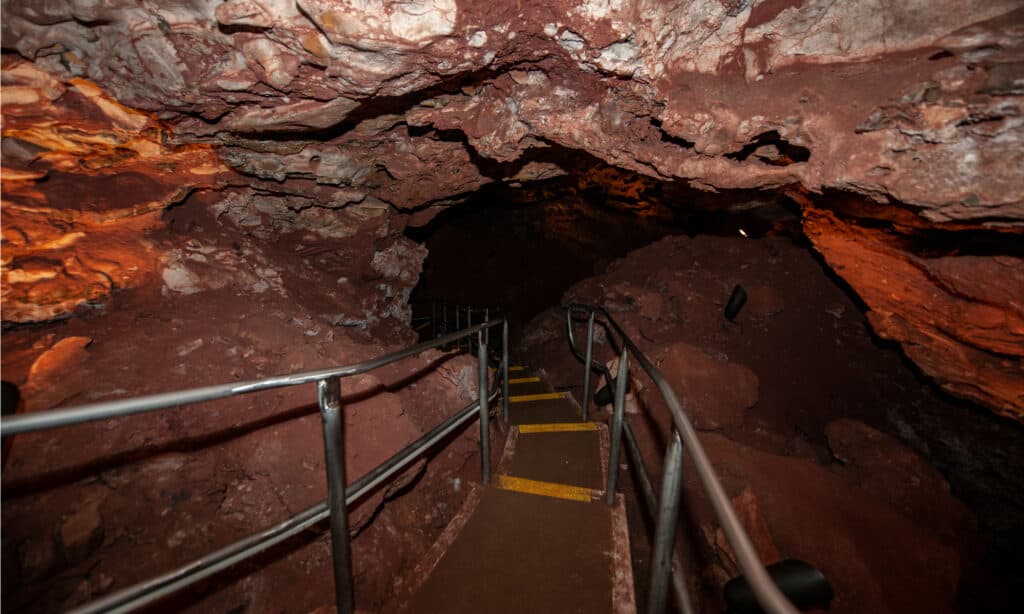
Wind Cave National Park in South Dakota happens to be one of the most overlooked gems in the nation, tucked into the Black Hills.
©Mahmoud Ghazal/Shutterstock.com
All year, scheduled, ranger-led tours of Wind Cave may be taken. The cave is closed on Thanksgiving, Christmas Day, and New Year’s Day. You can purchase tickets and find out more about the schedule and timing by visiting the Visitor Center, where tours begin.
The caves include some 100 miles of passages, with eight miles currently on maps. The tours cover anywhere from 0.25 miles on a 1-hour tour to 0.5 miles in a 2-hour tour. These tours follow the lighted walkways through the underground passageways covered in unique formations. The three tours involve a series of stairs, so, unfortunately, they are not accessible for folks using walkers, wheelchairs, strollers, or canes.
- Natural Entrance Tour climbs down 300 to 450 stairs
- Fairgrounds Tour climbs down 300 to 450 stairs
- Garden of Eden Tour climbs down 150 stairs
Additionally, from mid-June to mid-August, two other tours are available. The 1-mile Candlelight Tour uses only the light of hand-held candle lanterns for a more authentic “ancient days” experience. The Caving Tour, suitable only for physically fit individuals, allows visitors to experience the 3,000-foot passage via crawling, walking, and climbing on a 3- to 4-hour trek. Both tours require reservations. When you visit, be sure to wear shoes with proper gripping action, as the routes may be slippery. Wear a jacket, as the cave is 53-degrees F year-round. Be sure to consider any breathing, heart, or walking problems before attending a tour and check with your doctor first.
The photo featured at the top of this post is © Mahmoud Ghazal/Shutterstock.com
Thank you for reading! Have some feedback for us? Contact the AZ Animals editorial team.



